To printHow to end a clogged toilet
You arrive in the bathroom and you realize that the toilet is clogged and you wonder what to do. Before you call the a1plumbersbristol , here are a few things you can try to fix the problem on your own.
The causes of the problem
Everyone agrees that fixing a toilet is not the most enjoyable job to do, especially if you don't know the source of the problem. Here are some of the causes:
An accumulation of limescale which causes a decrease in pressure;
An object inadvertently dropped into the toilet blocking the bottom of the bowl;
The mechanism housed in the tank which is defective. Flush the toilet to check if the rubber valve closes completely to allow the tank to fill;
Over time, the small chain connecting the valve to the mechanism may break;
You can repair the chain by removing a link or by purchasing the necessary parts from your hardware store.
To clear a blocked bowl
If this is not a problem with the tank piping, perhaps it is an object stuck at the bottom of the bowl or in the pipe.
Siphon
The siphon is the most common tool used to deal with a blocked toilet.
The air pressure and the suction effect caused by the reciprocating movements exerted with the siphon should effectively clear what was temporarily obstructing the pipe.
It would be wise to place towels or old rags around the toilet because of the splashing water that this operation can produce.
Toilet Ferret
If the water level in the toilet bowl is abnormally high, there is a good chance it is due to the amount of lime that has accumulated over the years. If so, just use a bent wire, commonly referred to as a "toilet ferret".
This tool will help you remove lime deposits:
Handle the ferret carefully to avoid any friction on the porcelain of the bowl;
Then use a brush to remove the lime and clean the hole;
Flush the toilet to clear the residue and check if the pressure has returned to normal.
Blocked piping
If the water level does not return to normal after using the snake, the piping may be blocked.
It is then sufficient to inspect the pipe which connects the tank to the bowl. Here too, lime deposits may have accumulated.
Call the plumber
If, after all these operations, the problem persists, call a plumbing professional, especially if it is a major repair to the pipe.
Your plumber will be able to identify the cause of your clogged toilet and can perform the necessary work.
By not skipping any steps before calling the plumber, you will probably be able to resolve the problem on your own. If nothing ever works, you can explain to the plumber everything you already have so that they don't start with these basic steps and charge you a fee.
4 very simple tips for repairing a toilet
No one likes a leaky or clogged toilet. Here are 4 very simple tips to help you remedy toilet problems in two steps.
If you take good care of it, your toilet can last a very long time. It only takes a few minor, regular maintenance jobs to keep it running smoothly and prevent it from letting you go at an inopportune time. A broken float mechanism, the rubber valve that does not close completely, the flush lever that remains in your hands or the clogged bowl are the main problems that can arise over time.
1. Inspect regularly
By inspecting parts on an ad hoc basis and replacing those that have had their day, you are putting the odds in your favor.
Despite your foresight, emergency repairs may be necessary.
2. Fix a leaking toilet
The malfunction of the reservoir mechanism often results in leaks. If so, check the condition of the valve. The wear of the cap can cause it to pass water when it closes. It will then be sufficient to replace it.
Perhaps the small chain which connects the valve to the mechanism is too long and prevents the stopper from closing properly.
A leaking toilet can also be repaired by tightening or loosening the float rod adjustment screw. This will have the effect of raising or lowering the water level. Test until you get the correct setting.
If the float is worn too much, it will have to be changed. It would be good to check the float seal.
Since many of the parts of the mechanism are in contact with water, they can rust over time. By regularly inspecting screws and nuts, you will be able to know their condition and replace them if necessary.
The flush lever which, once activated, allows the water to be emptied from the tank is also a part liable to break. To remove it, just open the tank and unscrew the part.
3. Unclog a toilet
If you're struggling with a clogged toilet, a few checks can help you fix the problem.
While a suction cup plunger may do the trick temporarily, the solution may lie in doing more important work, such as replacing the plumbing.
4. Ask for help
The constant noise of water leaking, condensation on the tank and the presence of a trickle of water around the toilet are just some of the signs that your toilet needs repair.
While some minor work can be done by the owner, others, more important, require the expertise of a professional.
Do not hesitate to call your plumber to have your toilet repaired. This will ensure that the repairs are carried out according to the rules of the art and that the problem will be solved once and for all.




Comments
Post a Comment